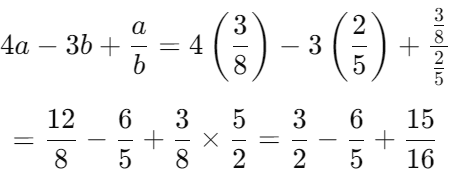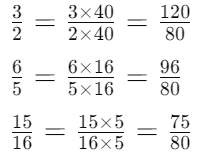Unit Tests(Solutions): Rational Numbers | Mathematics (Maths) Class 8 PDF Download
Time: 1 hour
M.M. 30
Attempt all questions.
Question numbers 1 to 5 carry 1 mark each.
Question numbers 6 to 8 carry 2 marks each.
Question numbers 9 to 11 carry 3 marks each.
Question number 12 & 13 carry 5 marks each
Q1: The product of and is a rational number. (True/False) (1 Mark)
Ans: True
A rational number is any number that can be expressed as a fraction , where and are integers, and is not equal to zero.
The given problem involves multiplying two rational numbers:
The result of this multiplication is , which is a fraction, and hence a rational number.
Since both the numbers being multiplied are rational, their product is also a rational number. Therefore, the statement is True.
Q2: Write in standard form (lowest terms, positive denominator):  (1 Mark)
(1 Mark)
Ans: 
Q3: What is the multiplicative inverse of ? (1 Mark)
Ans: The multiplicative inverse is .
Q4: Rational numbers are not closed under which operation? (1 Mark)
(i) Addition
(ii) Subtraction
(iii) Multiplication
(iv) Division
Ans: (iv)
Division (because dividing by zero is not defined).
Q5: What is the additive identity of rational numbers? (1 Mark)
Ans: The additive identity of rational numbers is 0. When 0 is added to any rational number, the result is the number itself. For example, 5 + 0 = 5.
Q6: A wire of length meters is cut into two pieces. If one piece is meters long, how long is the other piece? (2 Marks)
Ans: Total length of wire = meters
Length of one piece = meters
Length of the other piece = meters.
Q7: Verify if the rational numbers -3/4 and -8/5 are closed under multiplication. (2 Marks)
Ans:
Q8: How does the associative property apply to the addition of rational numbers? (2 Marks)
Ans:
The associative property of addition states that the way in which numbers are grouped does not affect the sum. For rational numbers, . For example:
Both sides will give the same sum, demonstrating the associative property.
Q9: (i) Simplify the expression and express it as a single rational number. (3 Marks)
Ans:
Find a common denominator:
So, the simplified expression is .
(ii) Match the following properties with their descriptions: 
Ans:
(i) - (b)
(ii) - (c)
(iii) - (a)
Q10: If and , solve the expression . (3 Marks)
Ans: Substitute and into the expression:
To simplify the expression, find a common denominator for the fractions:
For , , and , the least common denominator (LCD) can be calculated as follows:
The denominators are 2, 5, and 16.
The LCD of 2, 5, and 16 is 80.
Convert each fraction to have the denominator of 80:
Now, substitute these values into the expression: Q11: (i) Find any three rational numbers between and . Show your working. (3 Marks)
Q11: (i) Find any three rational numbers between and . Show your working. (3 Marks)
Ans: Make equal (larger) denominators so that numbers in between are visible.
Rational numbers strictly between and include:
Therefore, three rational numbers between and are
(ii) Prove that the sum of two rational numbers is always a rational number.
Ans: Let and be two rational numbers. Their sum is:
Since and are integers, and , the result is a rational number.
Q12: If and , solve the following expression:
Answer: Let's solve the expression where and
Calculate
Calculate 4y:
Calculate :
1
Now, substitute these into the original expression:
1
Find a common denominator for and :
The common denominator of 4 and 3 is 12.
Convert to have a denominator of 12:
Convert 38 to have a denominator of 12:
Now add the fractions and subtract 1:
Final Answer:
Q13:
Ans: Find a common denominator for the left side:
The common denominator for 5 and 4 is 20.
Convert to have a denominator of 20:

Convert to have a denominator of 20:
Combine the fractions on the left side: Now, the equation becomes:
Now, the equation becomes: Since the denominators are the same, set the numerators equal to each other:
Since the denominators are the same, set the numerators equal to each other:
23x−2=7x−1
23x−7x−2=−1
16x−2=−1
16x=1
x=1/16
|
81 videos|423 docs|31 tests
|
FAQs on Unit Tests(Solutions): Rational Numbers - Mathematics (Maths) Class 8
| 1. What are rational numbers and how are they represented? |  |
| 2. How do you add and subtract rational numbers? |  |
| 3. Can rational numbers be negative? |  |
| 4. What are some examples of rational numbers? |  |
| 5. How do you convert a decimal to a rational number? |  |

















